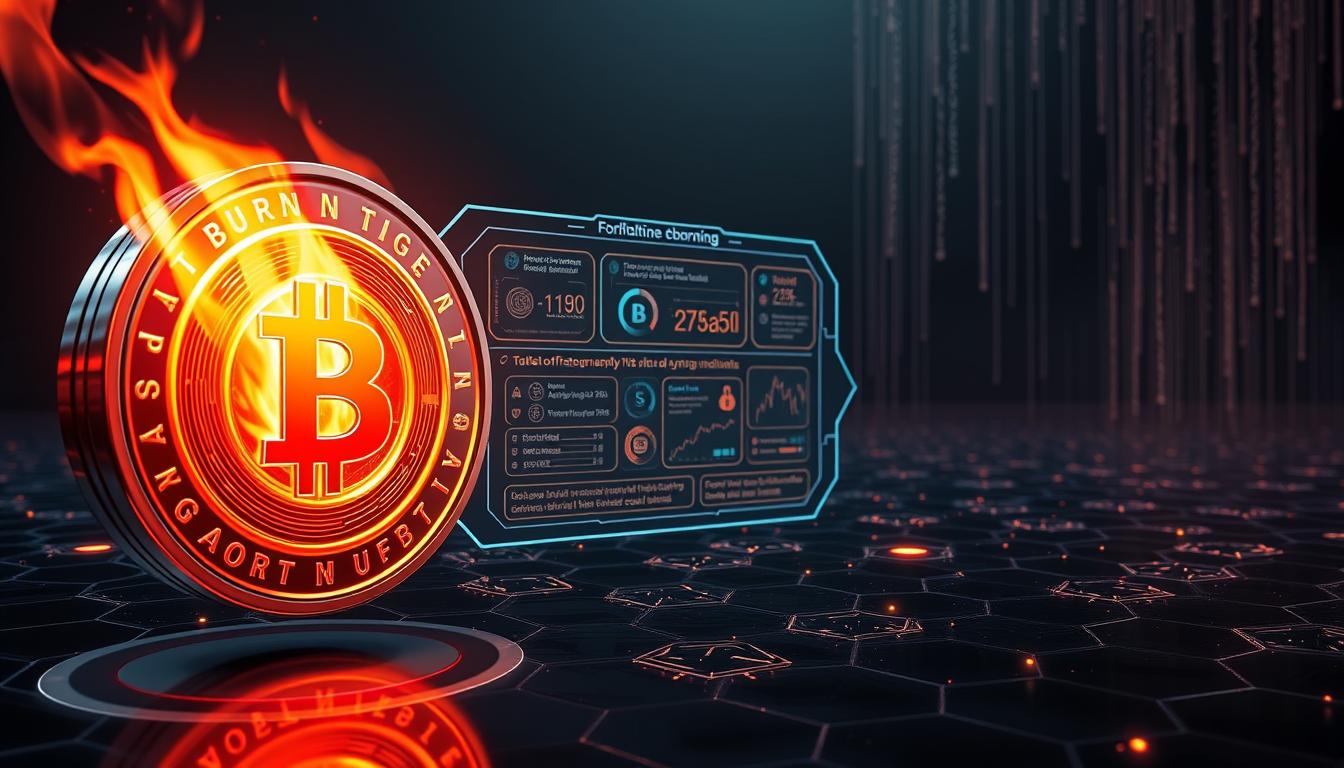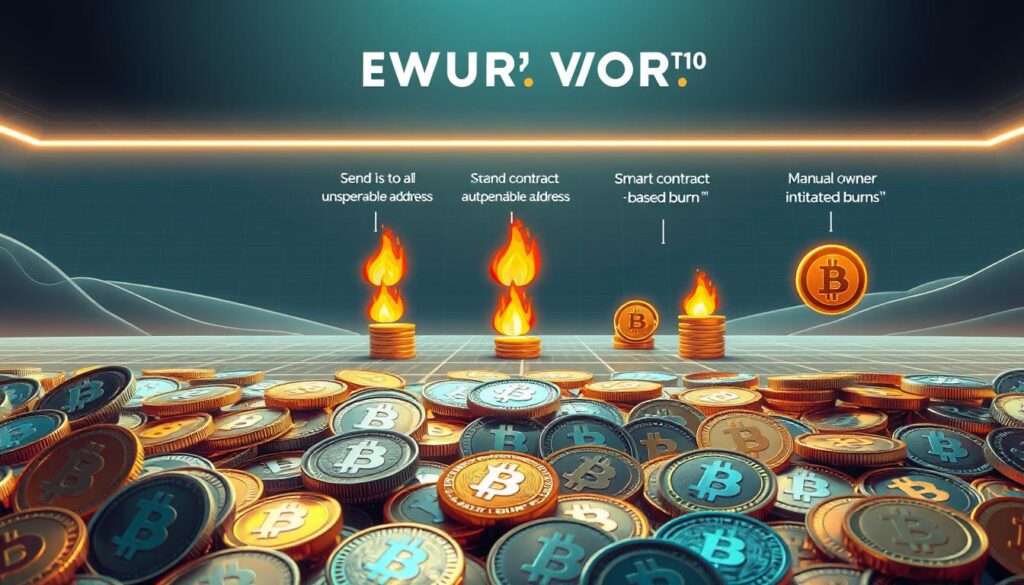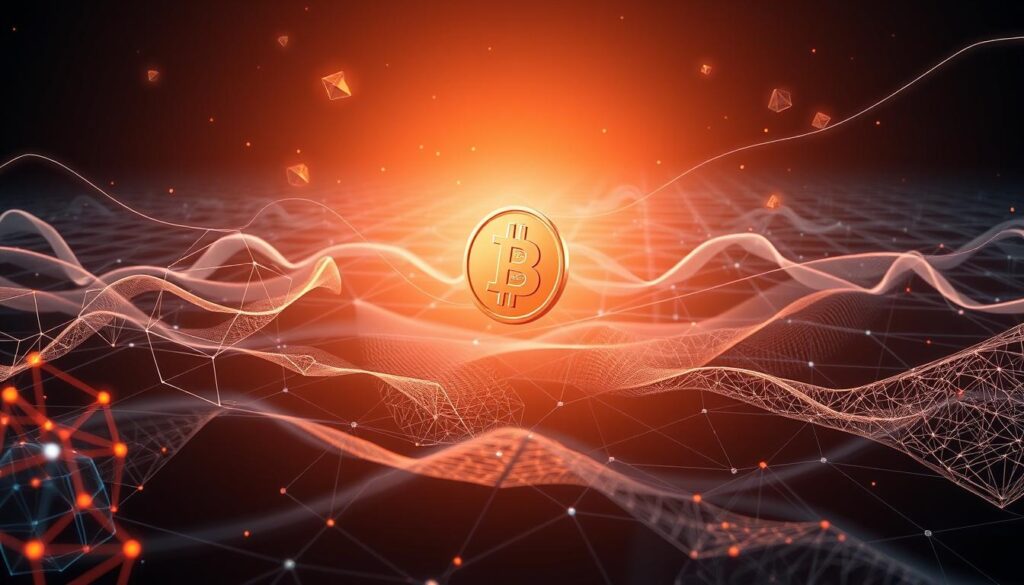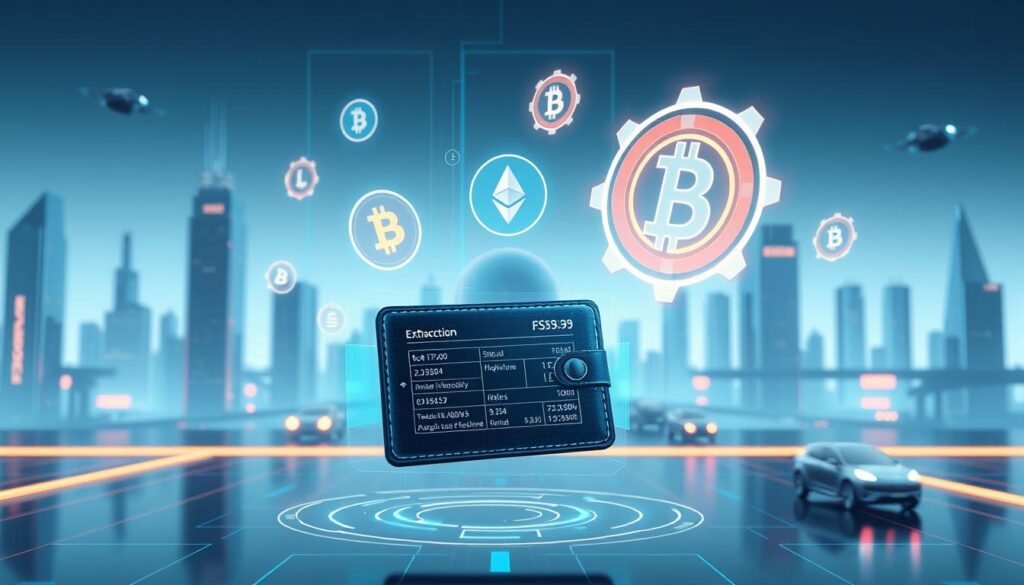Now Reading: Cryptocurrency burn deflationary supply mechanism Explained
- 01
Cryptocurrency burn deflationary supply mechanism Explained
Cryptocurrency burn deflationary supply mechanism Explained

Digital assets are changing how we think about money. A key idea in this space involves managing how many tokens exist. This process aims to increase their worth over time.
Token burning has become a popular method for crypto projects. It creates a deflationary pressure on the total number of tokens available. By permanently destroying tokens, projects can create a provable scarcity model.
So, what is token burning? It means permanently removing tokens from circulation. This is done by sending them to a special, verifiable address. Once sent, these tokens are gone for good, reducing the total supply.
This concept is simple but powerful. With a fixed or declining token supply, and steady or increasing demand, the value of each remaining token can rise. This makes the asset more attractive to long-term holders.
This guide will explore how this mechanism works. We will look at real-world examples and the benefits for investors. Understanding this process is key to navigating the modern cryptocurrency market.
Key Takeaways
- Token burning is a process that permanently removes tokens from circulation.
- This action reduces the total supply, creating a model of scarcity.
- A lower supply with steady demand can put upward pressure on a token’s value.
- The process is transparent and can be verified on the blockchain.
- This mechanism contrasts with traditional inflationary models where supply increases.
- It is a strategy used to reward long-term holders of a digital asset.
Introduction to Cryptocurrency Burn Deflationary Supply Mechanisms
The concept of verifiable scarcity is revolutionizing how digital assets gain value. This approach moves beyond simple creation to include deliberate reduction. It forms the basis of a powerful economic model.
What Is Token Burning?
Token burning is the deliberate act of permanently removing units from circulation. This is achieved by sending them to a special wallet address, often called an “eater address.” The private keys for this wallet are unknown, making recovery impossible.
This action creates a transparent and auditable record on the blockchain. Anyone can verify that the tokens are gone for good. This process reduces the total number of tokens available.
Burns can happen in different ways. Some are one-time events, while others are scheduled. Automatic burns can also be tied to transaction fees, creating a continuous effect.
Why Deflationary Supply Matters
A decreasing token supply matters due to basic economics. When the number of tokens goes down, but interest stays the same or grows, each remaining unit becomes more rare. This scarcity can lead to price appreciation.
This model stands in contrast to traditional systems where supply often increases. For investors, a project that actively reduces its supply signals a commitment to long-term value. It builds trust and confidence among holders.
This alignment of incentives between creators and owners is key. It creates a predictable policy that protects against value dilution. This makes such assets attractive for those seeking growth.
Cryptocurrency burn deflationary supply mechanism
Token reduction strategies come in multiple forms with distinct operational approaches. Each method serves the same ultimate purpose but follows different implementation paths.

Mechanism Overview
Projects can choose from several approaches to reduce their digital asset quantities. Manual removal involves team decisions about timing and amount. This method allows for strategic planning around project milestones.
Automatic reduction happens through programmed contracts. A percentage of each network activity gets permanently removed. This creates consistent pressure over time.
Buyback strategies involve market purchases followed by destruction. This demonstrates confidence while reducing available units. Transaction-based removal ties the process directly to network usage.
Community participation options allow holders to voluntarily reduce their holdings. Special portals often facilitate this process. Some projects offer incentives for participation.
| Method Type | How It Works | Key Feature | Frequency |
|---|---|---|---|
| Manual | Team-initiated events | Strategic timing | Periodic |
| Automatic | Smart contract execution | Consistent reduction | Continuous |
| Buyback | Market purchase + destruction | Value demonstration | Variable |
| Transaction-based | Fee percentage removal | Usage-linked | With each transaction |
| User-initiated | Holder voluntary action | Community involvement | Optional |
Impact on Tokenomics and Scarcity
These reduction methods fundamentally change an asset’s economic model. As quantities decrease, basic economic principles take effect. Steady or growing interest creates upward pressure on individual unit worth.
The effectiveness depends on transparent execution and community understanding. Proper implementation can lead to sustainable value growth. This approach contrasts with traditional inflationary models.
Benefits of Token Burning and Creating Scarcity
Projects that incorporate token destruction mechanisms gain several competitive advantages in the market. These strategies create value through multiple channels that benefit various stakeholders.
Enhancing Token Value
Reducing available units creates natural scarcity in the market. When interest stays constant or grows, this scarcity pushes individual unit worth upward.
The economic principle is straightforward. Fewer available tokens mean each remaining one becomes more valuable. This creates a positive cycle of appreciation over time.

Rewarding Holders and Building Trust
Existing investors benefit directly from reduction events. Their holdings represent a larger share of the total after each removal. This rewards loyalty without requiring new token distribution.
Transparent on-chain events build confidence among participants. Unlike traditional financial systems, these actions are publicly verifiable. This clarity around monetary policy fosters long-term trust.
Some initiatives even align economic incentives with environmental goals. For example, certain networks destroy units used for carbon credit purchases. This demonstrates commitment to sustainable practices.
| Benefit Category | Primary Impact | Stakeholders Served | Long-term Effect |
|---|---|---|---|
| Value Enhancement | Price appreciation | All holders | Sustainable growth |
| Holder Rewards | Increased share value | Long-term investors | Loyalty reinforcement |
| Trust Building | Transparent policy | Community members | Confidence strengthening |
| Ecosystem Growth | Resource allocation | Project development | Network expansion |
Understanding these token burn mechanisms helps investors make informed decisions. The strategic benefits extend across the entire digital asset landscape.
Real-World Examples and Case Studies of Token Burns
The theoretical benefits of supply reduction become tangible when examining actual implementations across various ecosystems. Major projects have demonstrated how strategic removal programs can create measurable impacts.

US Market Implementations
American markets have embraced this approach with significant milestones. Coinbase conducted the first major US-based removal in 2018, eliminating 100,000 ERC-20 units.
By 2022, over 100 such events occurred across US-based initiatives. Binance executed the largest American market removal in 2021, destroying 100 million BNB units.
Global Adoption and Success Stories
International networks show diverse implementation strategies. Solana’s July 2022 event removed over 1.3 million SOL units valued at $500 million.
Cardano began monthly eliminations in March 2022, with July seeing 500,000 ADA removed. Shiba Inu’s portal launch burned 9.2 million SHIB in 24 hours, sparking a 20% price increase.
An April 2025 event saw 280 million SHIB eliminated in one transaction, increasing the daily removal rate by 37,937%.
| Project | Approach | Scale | Impact |
|---|---|---|---|
| Binance Coin | Quarterly profit-based | 100 million units | Market confidence |
| Ethereum | Transaction fee elimination | Continuous process | Network efficiency |
| SafeMoon | Automatic 10% fee split | 5% to holders, 5% removed | Community rewards |
| Shiba Inu | Portal-based community | 280 million in one event | Price momentum |
Key Steps to Implement a Token Burn Strategy
Implementing a token reduction program requires careful technical and strategic planning. Projects must balance backend development with user experience design to create an effective system.
Developing Smart Contracts for Burns
The foundation begins with specialized contract creation. This code must include external functions allowing holders to permanently remove their assets.
Transparent event logging is crucial for accountability. Each removal should record amount, timestamp, and initiating address on-chain.
Clear objectives guide the entire process. Whether creating scarcity or boosting confidence, goals determine technical parameters.
Frequency and volume settings must align with the project’s economic model. These decisions affect long-term value creation.
Setting Up a User-Friendly Burn Portal
Frontend interfaces make the process accessible to all users. Wallet integration should be seamless and secure.
Gamification elements can drive participation. Leaderboards and quests create engaging experiences for the community.
Proper implementation requires sending assets to verifiable addresses where recovery is impossible. This ensures permanent removal from circulation.
Transparent communication builds trust throughout the token burning process. Regular updates and analytics demonstrate commitment to the strategy.
Integrating Token Burns into Broader Cryptocurrency Ecosystems
Strategic integration transforms basic removal actions into powerful ecosystem drivers. These approaches weave reduction efforts into multiple platform aspects.
This creates natural value enhancement through regular user activities.
Ecosystem and Network Growth Strategies
Projects can embed reduction processes within staking protocols. This rewards participants who lock their assets while reducing available quantities.
The approach creates dual benefits of scarcity and incentivized participation.
Governance models offer another integration path. Users might sacrifice units to gain enhanced voting power.
This aligns incentives with active community involvement. The most committed members gain greater influence.

Reward systems can create deflationary loops through strategic design. Users receive incentives for positive behaviors like providing liquidity.
A portion of these rewards gets permanently removed. This reduces total count while encouraging desired actions.
Collaborations and Community Engagement
Partnerships with exchanges amplify initiative impact. Promotional campaigns and matching events drive broader participation.
Increased visibility helps educate wider audiences about the value proposition.
Community engagement tactics transform economic actions into social experiences. Contests and recognition programs build identity around shared goals.
Successful strategies feel natural rather than forced. Users participate for tangible benefits like exclusive access or enhanced rights.
Monitoring Metrics and Long-Term Impacts of Deflationary Supply
Measuring the impact of token reduction initiatives involves analyzing multiple data points across different timeframes. This comprehensive approach helps projects understand how their strategies perform over extended periods.
Tracking Burn Rates and Circulating Supply
The removal rate indicates how quickly assets are being taken out of circulation. Monitoring this metric daily, weekly, and monthly reveals important patterns.
A higher removal rate suggests stronger economic pressure. This can lead to price increases as available tokens become more scarce.
Projects should compare actual supply reduction against their targets. This helps evaluate whether the pace meets stated objectives.
Assessing Market Reaction and Token Value Appreciation
Analyzing price movements around reduction events shows investor sentiment. Sharp increases often indicate positive market reception.
Trading volume provides additional context for price changes. High volume during these events suggests genuine market interest.
Token velocity measures how frequently assets change hands. Decreasing velocity suggests holders are adopting long-term strategies.
| Metric | Purpose | Frequency | Key Insight |
|---|---|---|---|
| Removal Rate | Measure reduction pace | Daily/Weekly | Economic pressure strength |
| Circulating Count | Track available assets | Continuous | Scarcity level |
| Price Movement | Gauge market response | Event-based | Investor sentiment |
| Trading Volume | Assess participation | Real-time | Market interest depth |
| Asset Velocity | Measure holding patterns | Monthly | Long-term strategy adoption |
Conclusion
Permanently removing tokens from circulation represents a powerful economic strategy that benefits all stakeholders. This approach has gained significant traction across the digital asset landscape.
Major projects worldwide have adopted these methods, demonstrating their effectiveness. The clear advantages include boosting asset worth and rewarding loyal participants.
As traditional financial systems face inflationary pressures, these reduction models offer attractive alternatives. They position digital assets as valuable stores of wealth.
Successful implementation requires thoughtful planning and community engagement. When executed well, these strategies create sustainable growth models.
Token reduction has established itself as an essential tool for building lasting value. It aligns incentives between creators and holders while fostering ecosystem expansion.
FAQ
What is the purpose of a token burn?
The main goal is to reduce the total number of coins in circulation. By permanently removing tokens from the available pool, projects aim to create scarcity. This limited availability can, over time, support price appreciation and benefit long-term holders.
How does a deflationary model increase a coin’s value?
A deflationary model works by systematically decreasing the circulating supply. When demand stays the same or grows, but the number of available assets shrinks, basic economic principles suggest the price per unit should rise. This potential for value appreciation attracts investors.
Which major projects use token burning?
A> Several well-known networks employ this strategy. For instance, Binance Coin (BNB) conducts quarterly burns. Other examples include Ethereum after its EIP-1559 upgrade, which burns a portion of transaction fees, and Shiba Inu, which has executed large-scale burns.
Is a token burn good for investors?
It can be a positive signal. A planned burn strategy shows a project’s commitment to creating value for its community. It rewards holders by potentially increasing the worth of their remaining assets and can build trust in the project’s long-term economic plan.
How can I participate in a token burn event?
Participation varies. Some projects have user-friendly portals where you can voluntarily burn your holdings, often for rewards or exclusive access. In other cases, the process is automatic, handled by smart contracts that remove tokens from circulation through transaction fees or other programmed actions.
What metrics should I watch to track a burn’s effect?
Key indicators include the burn rate (how quickly tokens are being removed), the change in circulating supply, and the market’s reaction in terms of trading volume and price. Monitoring these metrics helps assess the long-term impact on the asset’s ecosystem and value.














